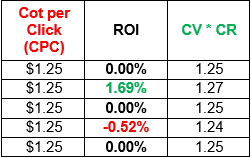Check out the 7 design elements every email marketing campaign should have for maximum compatibility, compliance, and success.

Check out the 7 design elements every email marketing campaign should have for maximum compatibility, compliance, and success.

In our experience with various B2B and enterprise clients, we’ve heard this proclamation in one way or another. If and when the discussion comes to this, we typically utilize the example of the Zero Moment of Truth (ZMOT), which essentially boils down to showing up at the right place, at the right time, and with the right content in order to capture customers at the key decision-making instant.
Being in a B2B sales environment doesn’t dehumanize this process, because people are still the ones making purchasing decisions. According to Google, 71% of people they spoke with use the internet on a daily basis for their business purchase decisions. The questions are: are you there (mobile, tablet, PC), is the content relevant, and is it delivered in a timely way?
Simply put, if you don’t have content being created on a regular basis, it’s going to be like mission impossible to not only acquire new customers, but retain existing ones. Research has shown that content is of utmost importance to all stages of the purchasing process. Having a plan around content marketing is mission-critical in terms of conveying your products’ features, benefits, and key differentiating factors.
This process starts with the right types of content. Content isn’t isolated to just words on pages, but also images and videos as well. People can find just about anything in the search results, from PDFs (brochures) to online video demos. All of these must work to both represent your brand and differentiate your company from the competition.
There are companies out there that I feel very familiar with, but that’s completely different from knowing enough to make a purchasing decision. Without proper details, research, and competitive information, the decision becomes far more difficult. This is because so many factors impact that final purchase decision, including the personnel involved (department heads, procurement, etc.).
Internal site search is a great opportunity to help these folks find relevant content about your company. However, if the best practices for organic search aren’t implemented across this information, it won’t matter how much you’ve invested in your enterprise search configuration. Garbage in means garbage out, and in this case, it means a poor experience for someone looking to learn more about (and maybe even purchase) your products.
But can you prove it? I’ve noticed that some B2B companies put a significant amount of their budgets into trade shows or conferences without assessing or measuring their influence on the purchasing process. Prospective clients may visit your booth or see an advertisement, but as some point, they’re going to want more proof that you’ve got the solution to their problems. The ideal setup for trade show marketing is a marketing mix that includes organic search, direct mail, a phone call, email, etc. (aka “multichannel”). In the end, it is the process behind nurturing these prospects that will drive sales growth.
You can assess the influence that most tactics that are associated with your marketing mix have on purchasing or lead generation. Organic search should go deeper than a simple justification of cost; it should also be a part of a cost analysis for all tactics within your marketing mix. It is the ability to identify what contributes to revenue and high profit margins which are vital to all businesses.
If you’re still unsure of the way organic search, content, and strategy work together in the B2B environment, then I would recommend the following:
Return (or Value) on Investment (Cost) is easy enough to understand, but applying the concept to PPC can be tricky. Before going further, you MUST have Conversion Tracking setup on your PPC. Without tracking Conversions, there is no way to measure the Return (Value) of your PPC efforts. Once you have Conversion Tracking set up and have assigned a monetary Value per Conversion, measuring the value of your PPC becomes easy. As for Cost, it is already measured for you within AdWords.
Now that we have the Return (Value) and Investment (Cost), ROI is a simple division problem away. But, do you really understand how you earned the value and where the cost went? The next step is breaking down the components that contribute to the ROI equation.
Cost is simply broken down into CPC or Cost per Click. While not every click is going to Cost the same, you will have an average CPC, which AdWords calculates for you, that can be used here. In a similar manner, Value can be broken down into Value per Conversion (from here on will be CV). This is very easy if you only have one Conversion type, but still doable with multiple Conversions (by using an average CV). When looking at the margin Cost and Value, we need a metric to tie the two together, which is where your Conversion Rate (CR), which is Conversions per Clicks, helps us.
At the breakeven point, your CPC = CV * CR. This also means that as long as CPC is less than CV * CR, you have a positive ROI. Below is a table illustrating the relationship of these metrics.

Taking a deeper look at this table, one will notice that whenever the CR drops below 10% the Campaign is in the red, but a CR above 10% brings it into the black, and while the CR is exactly 10% the Campaign is at its breakeven point. The next table uses the same figures but only includes the CPC, CV * CR, and ROI columns.

By looking at CPC and CV * CR, we can determine if a campaign has a positive ROI. Let us look at the final step, which is optimizing your Campaigns to boost your ROI.
Since there are two sides to this equation, there are two methods to boosting ROI.
1) Reduce CPC
2) Increase CV and/or CR
CPC can be reduced a few different ways. The quickest is to lower bids or pause keywords with high CPCs. Of course, it’s best to keep the ones that are earning Conversions, because we do not want to lower the value side of the equation. Another method is to increase your Quality Score. A higher Quality Score allows you to pay less without losing Ad Rank (or Ad Position). Making sure that your Ad Copy and Landing Page content are relevant and even includes your top performing keywords will help boost your Quality Score.
Next is increasing CV and/or CR. Since Conversion Value is more often a fixed amount, I am going to focus on Conversion Rate. Begin by making sure your Landing Page clearly tells the visitor what the desire action (Conversion) is and the next step to take to accomplish it. Next, include a clear call to action within the Ad Copy (i.e. Buy Online, Sign Up or Register). Lastly, confirm that your keywords and other settings are reaching the right target audience. If you want people make a purchase, then people just looking for information are not within your target audience. Ensuring that you are getting your Ads in front of the right audience will help increase CR and boost ROI.
Just knowing the ROI percentage of your PPC, whether it is positive or negative, is not enough. You must really understand how and why your PPC earned (or failed to earn) its ROI. By breaking the equation down into the marginal metrics (CPC and CV) and tying the metrics together with Conversions Rate, you can tell if your ROI is positive or negative. Then, the next step is to improve it. Is your Cost side too high? Then start working on lowering the CPC. On the other hand, is your value lacking? Look at targeting settings, Ad Copy, and Landing Pages to make sure you are guiding the right audience all the way through your Conversions Funnel.
Social media is an amazing communication channel. It allows for seamless connectivity in pretty much every aspect of our lives. This is true for individuals and organizations alike, and their overall objectives are largely the same: to build awareness of themselves, and to promote their message in a transparent manner.
Non-profit organizations are no exception. Social media can provide (and has been providing, see @charitywater) vast opportunities for growth and success. In my last blog, I talked about how easy it can be for organizations to bypass the “social” aspect of social media. For non-profits, the message is everything. Conveying that information to the public is a true art form and is made very manageable by social media networks’ communicative nuances. Which brings us to reason number one…
Every social media platform utilized by an organization should be a large part of their content strategy. While nonprofits tend to live and breathe their message every day, having a written plan surrounding that message will help to streamline social media communication efforts (as well as other content-based efforts, like press releases, brochures, etc.).
As humans, our emotions often play a large role in many of our decisions on a day-to-day basis. As such, the emotional response of the target audience plays a critical role in many nonprofit marketing strategies. In order to leverage the influence a nonprofit cause or message has, it’s important to plan the implementation of your information accordingly. In short – your information is powerful, so treat it as such.
Information travels so rapidly through social media that it can sometimes be hard to keep track. Twitter, for instance, has the power to directly reach over 120 million people in a matter of 2 minutes. Wielding the power to disseminate your information to a large audience with your fingertips is truly remarkable, and it should not be understated from a marketing standpoint. Which brings us to…
As your information continues to spread, awareness of your cause will grow. Individuals and businesses are always looking for new opportunities to volunteer (see Deb Wagner’s recent blog), and non-profits need to take advantage of their growth in the social space. According to this Social Media Today infographic, 90% of small businesses are utilizing social media. That’s a pie that nonprofits can’t miss out on a piece of!

In the same manner that non-profit organizations’ reach and visibility can grow in the social space, their advancement can greatly benefit as well. E-commerce continues to become more convenient and secure, and platforms are rolling out their solutions.
In 2013, Google released its One Today app – and with the tap of a finger, users could donate $1 to any charity that signed up (through an application process and creating a free profile). One Today profiles are easily linkable via any social media platform, so the fundraising process is as simple as a Tweet.
Youtube (or, ya know, Google) recently upgraded its Google for Non-profits offerings with their “donation button”. This allows for nonprofit Youtube channels to integrate a button underneath the video being played so viewers are merely a click away from helping out. Tying the message to conversions has never been easier.
Regardless of conversion methods or tactics, the message itself is what’s most important. The way nonprofits get involved and allow others to get involved is imperative in this digital age. At its core, social media gives the voices behind these great causes a megaphone to the masses. They’ve just got to turn it on to be heard.